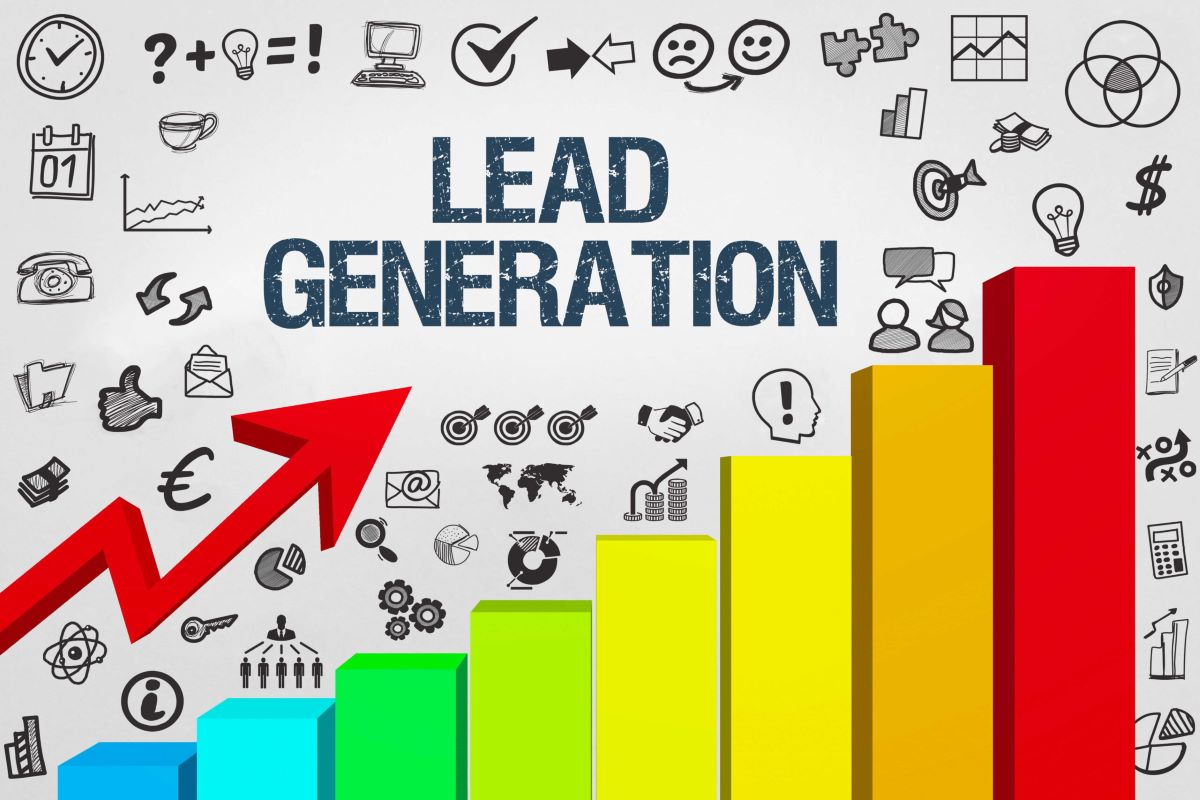

Finance
How To Generate Leads For Life Insurance
Modified: December 30, 2023
Learn effective strategies to generate leads for life insurance and boost your finance-related business with our comprehensive guide.
(Many of the links in this article redirect to a specific reviewed product. Your purchase of these products through affiliate links helps to generate commission for LiveWell, at no extra cost. Learn more)
Table of Contents
- Introduction
- Understanding the Importance of Lead Generation for Life Insurance
- Identifying Target Market for Life Insurance Leads
- Creating an Effective Lead Generation Strategy
- Utilizing Online Channels for Life Insurance Lead Generation
- Leveraging Social Media for Life Insurance Lead Generation
- Implementing Email Marketing Campaigns for Life Insurance Lead Generation
- Using Content Marketing to Generate Leads for Life Insurance
- Building and Optimizing Landing Pages for Life Insurance Lead Generation
- Conducting Webinars and Events for Life Insurance Lead Generation
- Measuring and Analyzing Lead Generation Campaigns for Life Insurance
- Conclusion
Introduction
Welcome to the world of life insurance lead generation! In today’s competitive market, generating high-quality leads is crucial for the success of any life insurance business. With the increasing number of insurance options and the growing awareness among individuals about the importance of financial security, it is essential to have a solid strategy in place to attract and convert potential customers into clients.
Lead generation refers to the process of capturing and nurturing potential customers who have shown interest in your insurance products or services. These leads can come from various sources, such as online channels, social media platforms, email campaigns, and content marketing efforts. The goal is not just to gather contact information but to engage and build relationships with prospects, ultimately leading to more conversions and sales.
In this article, we will explore the importance of lead generation for life insurance, identify the target market, and discuss effective strategies to generate high-quality leads. Whether you are an insurance agent, broker, or running an insurance agency, these insights will help you maximize your lead generation efforts and grow your business.
Remember, generating leads for life insurance is not a one-size-fits-all approach. It requires understanding your target audience, leveraging the right channels, crafting compelling messages, and constantly analyzing and optimizing your lead generation campaigns. By implementing the strategies outlined in this article, you will be well-equipped to generate a steady stream of leads and stay ahead in the competitive insurance industry.
Understanding the Importance of Lead Generation for Life Insurance
In the world of life insurance, lead generation is the backbone of a successful business. It is the process of attracting and capturing potential customers who are interested in purchasing life insurance policies. Generating high-quality leads is crucial for the growth and profitability of your life insurance business. Let’s explore why lead generation is so important:
- Increased Sales Opportunities: With a steady stream of leads, you have a greater number of sales opportunities. Each lead represents a potential customer who is interested in your life insurance products. By nurturing these leads, you can convert them into valuable clients, resulting in increased sales and revenue for your business.
- Targeted Audience: Through effective lead generation strategies, you can target your ideal audience. This means attracting individuals who are most likely to be interested in purchasing life insurance. By focusing your efforts on the right audience, you can increase the chances of conversion and save time and resources by not pursuing unqualified leads.
- Establishing Trust and Authority: Lead generation allows you to build trust and establish your authority in the life insurance industry. By providing valuable information, addressing customer concerns, and presenting yourself as a knowledgeable and reliable source, you can earn the trust of your leads. This trust and authority will contribute to higher conversion rates and long-term client relationships.
- Customer Relationship Building: Lead generation is not just about acquiring leads; it’s about building relationships. By engaging with your leads, providing personalized recommendations, and offering ongoing support, you can foster strong connections. This relationship-building approach will not only increase the chances of conversion but also lead to customer loyalty and referrals.
- Competitive Advantage: In the highly competitive life insurance market, effective lead generation strategies give you an edge over your competitors. By implementing innovative techniques, targeting niche markets, and staying ahead of industry trends, you can position yourself as a leader in the field. This competitive advantage will attract more leads and enhance your overall business performance.
It is clear that lead generation is a fundamental aspect of running a successful life insurance business. By understanding the importance of lead generation and implementing effective strategies, you can generate a consistent flow of high-quality leads and drive growth for your business.
Identifying Target Market for Life Insurance Leads
One of the key factors in successful lead generation for life insurance is identifying and understanding your target market. Knowing who your ideal customers are will allow you to tailor your marketing strategies and messages to resonate with them. Here are some steps to help you identify your target market for life insurance leads:
- Research and Segmentation: Begin by conducting market research to gain insights into the demographics and characteristics of your potential customers. Consider factors such as age, income level, occupation, marital status, and familial responsibilities. By segmenting your target market based on these criteria, you can create targeted marketing campaigns that appeal to specific groups.
- Evaluate Existing Customers: Analyze your existing customer base to identify commonalities and trends. Look for patterns in age groups, professions, and other relevant factors. This will help you understand which segments of customers are already attracted to your life insurance offerings and allow you to focus your efforts on attracting similar individuals.
- Consider Life Events: Consider the life events that often prompt individuals to seek life insurance coverage. For example, getting married, starting a family, buying a new home, or starting a business are all events that often drive the need for life insurance. By understanding these triggers, you can target individuals who are likely to be in these life stages.
- Identify Pain Points and Needs: Determine the pain points and needs of your target audience regarding life insurance. Understand their concerns, such as financial security, protecting their loved ones, or planning for the future. Craft your marketing messages to address these concerns and position your life insurance solutions as the answer to their needs.
- Utilize Data and Analytics: Leverage data and analytics tools to gather insights about your website visitors, social media followers, and email subscribers. Pay attention to their preferences, behavior, and interactions with your brand. Use this data to refine your target market and improve your lead generation strategies.
Remember, the target market for life insurance leads can vary based on the specific types of life insurance products you offer. For example, if you specialize in term life insurance, your target market might be different than if you focus on whole life insurance.
By investing time and effort into identifying your target market for life insurance leads, you can ensure that your lead generation strategies are highly targeted and yield better results. Understanding your audience will allow you to tailor your messaging, choose the right marketing channels, and attract individuals who are most likely to become valuable clients.
Creating an Effective Lead Generation Strategy
Now that you have identified your target market for life insurance leads, it’s time to develop an effective lead generation strategy that maximizes your chances of attracting and converting potential customers. Here are some key steps to create a successful lead generation strategy:
- Set Clear Goals: Define your lead generation goals. Do you want to increase the number of leads generated per month? Are you looking to improve the quality of leads? Establishing specific and measurable goals will help you stay focused and track your progress.
- Develop a Compelling Value Proposition: Clearly communicate the unique value your life insurance products offer to potential customers. Highlight how your solutions address their pain points and provide them with the security and peace of mind they seek.
- Create Irresistible Offers: Offer value to attract leads. Develop enticing offers such as free guides, informative ebooks, or consultations. These offers should align with the needs of your target market and provide valuable information or solutions.
- Optimize Your Website: Make sure your website is user-friendly, visually appealing, and optimized for lead generation. Implement clear call-to-action buttons, strategically place lead capture forms, and provide informative content that encourages visitors to take action.
- Leverage Paid Advertising: Consider investing in paid advertising to reach a wider audience. Platforms like Google Ads and social media advertising allow you to target specific demographics and interests. Use compelling ad copy and compelling visuals to capture attention and drive traffic to your lead capture pages.
- Implement Lead Magnets: Incorporate lead magnets throughout your marketing channels to entice visitors to share their contact information. These can be in the form of gated content, quizzes, calculators, or free tools that require users to provide their email or phone number in exchange for access.
- Utilize Referral Programs: Encourage your existing clients and leads to refer their friends, family, and colleagues to your life insurance services. Develop a referral program that offers incentives, such as discounts or rewards, to both the referrer and the new customer.
- Nurture Leads Through Email Marketing: Implement automated email marketing campaigns to nurture your leads. Develop a series of informative and engaging emails that provide value, educate leads about life insurance, and build trust over time.
- Monitor and Analyze Performance: Regularly track and analyze the performance of your lead generation campaigns. Measure key metrics such as conversion rates, click-through rates, and cost per lead. Use this data to identify areas for improvement and optimize your strategies.
Remember, an effective lead generation strategy requires regular monitoring, experimentation, and refinement. Keep up with industry trends, stay adaptable, and be willing to make changes to optimize your approach based on the insights you gather.
By following these steps and consistently implementing your lead generation strategy, you can attract qualified leads, establish strong relationships, and grow your life insurance business.
Utilizing Online Channels for Life Insurance Lead Generation
Online channels provide immense opportunities for generating life insurance leads. With a vast audience accessible through the internet, leveraging online platforms is crucial for reaching your target market effectively. Here are some key online channels to consider for your life insurance lead generation:
- Search Engine Optimization (SEO): Optimize your website and content to rank higher in search engine results. Conduct keyword research to identify relevant keywords and incorporate them naturally into your website’s pages, blog posts, and other content. This will help increase your visibility and attract organic traffic from individuals actively searching for life insurance information.
- Pay-Per-Click (PPC) Advertising: Create targeted PPC campaigns on platforms like Google Ads and Bing Ads. Bid on relevant keywords and create compelling ad copy to drive traffic to your website. Make sure your landing pages align with the ad copy and provide a clear call-to-action to capture leads effectively.
- Social Media Marketing: Establish a strong presence on social media platforms such as Facebook, LinkedIn, Twitter, and Instagram. Create engaging content that addresses your target audience’s life insurance needs and interests. Use targeted advertising campaigns on these platforms to reach specific demographics and drive traffic to your lead capture pages.
- Content Marketing: Produce high-quality content that educates, informs, and engages your target audience. Create blog posts, articles, videos, and infographics that cover various life insurance topics. Share this content through your website, social media channels, and email campaigns to attract and engage potential leads.
- Email Marketing: Build an email list and leverage it to nurture leads and convert them into customers. Send personalized and valuable content to your list to build trust and establish your authority in the industry. Use email automation to send relevant messages based on lead behavior and demographics.
- Online Directories and Review Sites: List your business on relevant online directories and review sites specific to the insurance industry. This will increase your visibility and credibility among potential clients who are actively looking for life insurance services.
- Webinars and Online Events: Conduct webinars and online events to showcase your expertise and services. Provide valuable information and address common concerns related to life insurance. Capture leads by requiring registration for the event and following up with attendees afterward.
- Chatbots and Live Chat: Implement chatbots or live chat functionality on your website to provide instant assistance and engage with visitors. Use these tools to answer questions, collect contact information, and guide potential leads through the sales process.
Remember to consistently analyze the performance of your online lead generation efforts. Monitor metrics such as website traffic, conversion rates, and engagement levels to identify areas for improvement. Adjust your strategies accordingly and refine your approach to optimize your online lead generation campaigns.
By utilizing online channels effectively, you can reach a wider audience, attract qualified leads, and ultimately grow your life insurance business.
Leveraging Social Media for Life Insurance Lead Generation
Social media platforms have become powerful tools for connecting with potential customers and generating leads for the life insurance industry. With billions of users worldwide, leveraging social media effectively can significantly impact your lead generation efforts. Here are key strategies for leveraging social media for life insurance lead generation:
- Choose the Right Platforms: Identify the social media platforms where your target audience is most active. Facebook, LinkedIn, and Twitter are commonly used for professional networking, while Instagram and TikTok are more visually focused. Select platforms that align with your target market demographics and communication preferences.
- Create Compelling Content: Develop a content strategy that highlights the value of life insurance and addresses your target audience’s needs and pain points. Share informative blog posts, videos, infographics, and customer testimonials. Illustrate real-life scenarios where life insurance provides financial security for individuals and their loved ones.
- Engage with Your Audience: Actively engage with your followers by responding to comments and messages. Encourage discussions, provide helpful information, and address any concerns or questions. This fosters trust and builds rapport with your potential leads.
- Collaborate with Influencers: Partner with influencers or industry experts who have a significant following on social media. They can promote your life insurance offerings to their audience, increasing your reach and credibility. Ensure that the influencers you choose have authentic connections with your target market.
- Run Targeted Advertising Campaigns: Utilize the advanced targeting options available on social media platforms to reach specific demographics. Tailor your ads to address the needs and concerns of your target audience. Create compelling visuals and ad copy that capture attention and encourage click-throughs to your lead capture pages.
- Host Q&A Sessions and Live Videos: Conduct Q&A sessions and live videos where you can address common questions and concerns about life insurance. This interactive approach allows your audience to get to know you and your expertise on a more personal level. Encourage viewers to submit questions in advance and during the live session to boost engagement and lead generation.
- Offer Exclusive Promotions and Contests: Entice your social media followers to engage and share your content by offering exclusive promotions, giveaways, or contests. Require participants to provide their contact information to enter, allowing you to capture leads for follow-up.
- Share Testimonials and Case Studies: Highlight success stories and testimonials from satisfied customers to demonstrate the value and benefits of life insurance. Potential leads are more likely to trust your offerings if they see positive experiences from others.
Remember to consistently monitor and analyze the performance of your social media lead generation efforts. Track key metrics such as engagement rate, click-through rate, and conversion rate to assess the effectiveness of your strategies. Adjust your approach based on the insights you gain to optimize your social media lead generation campaigns.
By leveraging social media effectively, you can expand your reach, engage with your target audience, and attract qualified leads for your life insurance business.
Implementing Email Marketing Campaigns for Life Insurance Lead Generation
Email marketing is a powerful tool for nurturing leads and converting them into clients in the life insurance industry. By implementing effective email marketing campaigns, you can build relationships, educate your audience, and encourage them to take action. Here are key strategies for implementing email marketing campaigns for life insurance lead generation:
- Build a Targeted Email List: Develop an email list of individuals who have expressed interest in your life insurance products or have opted in to receive communication from you. Offer valuable content, such as informative ebooks or guides, in exchange for email addresses. Segment your list based on demographics, preferences, and where they are in the buyer’s journey.
- Create Compelling and Personalized Content: Craft engaging and personalized emails that resonate with your target audience. Address their specific pain points, concerns, and aspirations related to life insurance. Tailor your messages to different customer segments to provide relevant information and showcase the value of your offerings.
- Use Automation and Drip Campaigns: Set up automated email sequences and drip campaigns to deliver a series of targeted messages over time. This helps nurture leads and keeps them engaged throughout their customer journey. Gradually introduce more detailed information about your life insurance products, benefits, and testimonials to build trust and encourage conversion.
- Offer Valuable Resources: Share valuable resources, such as educational content, blog posts, and industry news through your email campaigns. This positions you as a trusted authority and keeps your brand top of mind for your leads. Regularly provide them with insights and solutions to their life insurance needs.
- Include Clear and Compelling Call-to-Action: Every email should have a clear call-to-action (CTA) that prompts your leads to take the desired action, such as scheduling a consultation or requesting a quote. Make your CTAs stand out visually and ensure they are easy to understand and act upon.
- Personalize and Segment Your Emails: Leverage personalization and segmentation techniques to deliver more targeted and relevant content. Address your leads by their names and customize the email content based on their preferences, demographics, and behaviors. This personal touch increases engagement and improves conversion rates.
- Test and Optimize: Continuously test and optimize your email campaigns to improve their effectiveness. Experiment with different subject lines, email layouts, CTAs, and sending times to identify what resonates best with your audience. Analyze open rates, click-through rates, and overall engagement metrics to make data-driven improvements.
- Comply with Data Privacy Regulations: Ensure that your email marketing campaigns comply with relevant data privacy regulations, such as the General Data Protection Regulation (GDPR) or the CAN-SPAM Act. Obtain proper consent and provide clear options for unsubscribing from your emails.
Remember to strike a balance between educational content and promotional messages in your email campaigns. Aim to provide value to your leads and build trust over time. Consistently monitor your email marketing performance and adjust your strategies to maximize engagement and conversion rates.
By implementing effective email marketing campaigns, you can nurture leads, showcase the benefits of life insurance, and ultimately grow your customer base.
Using Content Marketing to Generate Leads for Life Insurance
Content marketing plays a crucial role in generating leads for the life insurance industry. By creating and sharing valuable and informative content, you can attract potential customers, establish yourself as a trusted authority, and ultimately drive conversions. Here are key strategies for using content marketing to generate leads for life insurance:
- Identify Your Target Audience: Understand your target market’s demographics, needs, and pain points. This will help you create content that resonates with your audience and addresses their specific concerns related to life insurance.
- Create High-Quality Educational Content: Develop content that educates and informs your audience about the importance of life insurance. Write blog posts, articles, and guides that explain various types of insurance policies, coverage options, and the benefits they provide.
- Optimize Your Content for Search Engines: Conduct keyword research to identify relevant keywords and incorporate them naturally into your content. This will improve your search engine rankings and make it easier for potential customers to discover your content when searching for life insurance information.
- Utilize Different Content Formats: Diversify your content formats to cater to different preferences. Create informative videos, infographics, podcasts, and interactive tools to engage your audience and offer valuable insights on life insurance topics.
- Promote Your Content: Share your content across various channels, such as your website, social media platforms, online forums, and industry-specific communities. Utilize email marketing campaigns to distribute your content to your subscriber base.
- Guest Blogging and Collaboration: Establish partnerships with industry influencers or invite guest bloggers to contribute to your website. This not only enhances the credibility and variety of your content but also expands your reach by tapping into the guest bloggers’ audience.
- Offer Gated Content: Develop premium content, such as comprehensive guides, ebooks, or white papers, that require visitors to provide their contact information before accessing it. This enables you to capture leads and continue nurturing them through email marketing.
- Showcase Customer Success Stories: Share testimonials and case studies that highlight successful life insurance experiences and the benefits your clients have gained. Real-life stories can resonate with potential customers and demonstrate the value of your services.
- Engage with Your Audience: Encourage comments, questions, and social media shares of your content. Respond promptly and engage in conversations to build relationships with your audience. This interaction fosters trust and establishes you as an approachable resource.
- Measure and Analyze: Monitor the performance of your content marketing efforts using analytics tools. Track metrics such as website traffic, engagement rates, time spent on page, and lead conversion. Analyze these insights to optimize your content strategy and drive better results.
Consistency and relevance are key to successful content marketing for lead generation. Regularly create and share valuable content that addresses the needs and concerns of your target audience. By providing informative and educational content, you can attract qualified leads, nurture them, and guide them towards choosing the right life insurance solutions.
Building and Optimizing Landing Pages for Life Insurance Lead Generation
Landing pages are a vital component of any successful life insurance lead generation strategy. When optimized properly, they can capture the attention of potential customers and encourage them to take the desired action, such as requesting a quote or scheduling a consultation. Here are key strategies for building and optimizing landing pages for life insurance lead generation:
- Create a Clear and Compelling Value Proposition: Clearly communicate the unique benefits and value your life insurance products offer. Highlight how your solutions address the needs and concerns of your target audience.
- Keep the Design Clean and Engaging: Use a clean and visually appealing design that aligns with your brand and evokes trust. Ensure that your landing page is mobile-responsive and loads quickly to provide a seamless user experience.
- Include a Strong Call-to-Action (CTA): Place a clear and prominent CTA on your landing page to guide visitors to take action. Use action-oriented language that prompts them to fill out a form or contact you for more information.
- Minimize Distractions: Eliminate unnecessary distractions on your landing page to keep the focus on the desired action. Remove navigation menus, sidebars, and superfluous content that may divert visitors’ attention away from the main purpose of the page.
- Create an Attention-Grabbing Headline: Craft a compelling headline that immediately captures the visitor’s attention and communicates the unique selling proposition of your life insurance offerings. Use persuasive language and address specific pain points to capture interest.
- Include Testimonials and Social Proof: Feature testimonials or reviews from satisfied customers to build trust and credibility. Incorporate logos of industry associations or certifications to further establish your expertise in the field of life insurance.
- Utilize Lead Capture Forms: Place a well-designed lead capture form on your landing page to collect contact information from potential leads. Keep the form concise and only ask for essential information to increase the likelihood of form completions.
- Offer Incentives: Provide incentives to encourage visitors to complete the lead capture form. Offer a free consultation, exclusive content, or a discount as a reward for providing their contact details.
- Optimize for Search Engines (SEO): Incorporate relevant keywords in the page title, headings, and meta description to improve your landing page’s visibility in search engine results. Ensure that the content is well-structured with proper headings and paragraphs.
- Test and Analyze: Perform A/B tests with different variations of your landing page to identify the most effective elements, such as headline, CTA placement, or form design. Continuously monitor the performance of your landing page using analytics tools and make data-driven optimizations.
Remember, the success of your landing pages depends on a combination of compelling content, visually appealing design, and seamless user experience. Continuously analyze your landing page’s performance, make necessary adjustments, and refine your approach to maximize your life insurance lead generation efforts.
By building and optimizing effective landing pages, you can capture the interest and contact information of potential leads and move them closer to becoming valuable life insurance clients.
Conducting Webinars and Events for Life Insurance Lead Generation
Webinars and events are powerful tools for generating leads in the life insurance industry. They provide an opportunity to showcase your expertise, establish credibility, and engage with potential customers. Here are key strategies for conducting webinars and events for life insurance lead generation:
- Choose Relevant Topics: Select topics that are relevant to your target audience and address their specific concerns and needs related to life insurance. Consider common pain points, recent industry trends, or changes in regulations that your audience would find valuable.
- Promote Your Webinar or Event: Use your website, social media platforms, email marketing, and other relevant channels to promote your webinar or event. Create compelling content and visuals that build anticipation and highlight the value attendees will gain by participating.
- Provide Registration and Capture Leads: Require attendees to register for the webinar or event, capturing their contact information in the process. This allows you to follow up with attendees and further nurture them as leads after the webinar or event.
- Create Engaging Content: Develop a well-structured presentation or workshop that delivers valuable information and insights. Use visuals, case studies, and real-life examples to engage your audience and illustrate the benefits of life insurance.
- Encourage Interaction: Incorporate interactive elements, such as polls, Q&A sessions, or live chat, during your webinar or event. This encourages active participation and engagement from attendees, creating a more memorable and impactful experience.
- Offer Special Incentives: Provide exclusive offers or promotions to webinar or event attendees to incentivize them to take the next step in their life insurance journey. This could include discounts on premiums, free consultations, or access to premium content.
- Build Credibility with Expert Speakers: Collaborate with industry experts or guest speakers who can contribute their knowledge and insights to the webinar or event. This adds credibility and diversity to the content, attracting a wider audience and enhancing the overall value of the event.
- Record and Repurpose the Content: Record your webinar or event and make it available for on-demand viewing. Repurpose the content into blog posts, social media snippets, or email newsletters to extend the reach and impact of the event, potentially attracting new leads.
- Follow Up with Attendees: Send personalized follow-up emails to webinar or event attendees, thanking them for their participation and providing additional resources or offers. Continue the conversation and nurture the relationship to convert attendees into qualified leads.
- Measure Success and Optimize: Track key metrics such as attendance rates, participant engagement, and lead conversions. Evaluate the success of your webinar or event and make improvements for future events based on attendee feedback and analytics data.
Remember, webinars and events are effective platforms for demonstrating your expertise, connecting with potential customers, and nurturing leads. By providing valuable content and fostering engagement, you can generate high-quality leads and build long-term relationships with individuals seeking life insurance solutions.
Measuring and Analyzing Lead Generation Campaigns for Life Insurance
To ensure the success of your lead generation efforts in the life insurance industry, it’s crucial to measure and analyze the performance of your campaigns. This allows you to understand what’s working, identify areas for improvement, and make data-driven decisions. Here are key strategies for measuring and analyzing lead generation campaigns for life insurance:
- Define Key Performance Indicators (KPIs): Clearly define the KPIs that align with your lead generation goals. Common KPIs include the number of leads generated, conversion rate, cost per lead, click-through rate, and engagement rate. Establish benchmarks and targets for each KPI to evaluate campaign effectiveness.
- Use Web Analytics Tools: Employ web analytics tools like Google Analytics to track and measure website traffic, user behavior, and conversion actions. Monitor landing page performance, referral sources, and page metrics to gain insights into visitor engagement and conversion rates.
- Implement Conversion Tracking: Set up conversion tracking on your lead capture forms, contact forms, quote request forms, or other desired actions. This enables you to attribute lead generation success to specific campaigns and channels, as well as understand which sources drive the highest quality leads.
- Analyze Email Metrics: Evaluate key email marketing metrics such as open rates, click-through rates, conversion rates, and unsubscribe rates. Identify trends, patterns, and segments that contribute to high engagement and conversion, guiding you in optimizing your email campaigns for better lead generation.
- A/B Test Landing Pages and CTAs: Conduct A/B tests where you compare variations of landing pages or call-to-action (CTA) elements to determine their impact on lead generation. Test different headlines, visuals, form layouts, and CTAs to identify which elements generate better engagement and conversions.
- Monitor Social Media Engagement: Track the performance of your social media campaigns in terms of reach, engagement, and click-through rates. Identify which platforms, content formats, and messaging strategies generate the highest levels of engagement and lead generation.
- Investigate Referral Sources: Analyze the referral sources of your website traffic and leads. Determine which channels, such as organic search, direct traffic, social media, or email marketing, are driving the most qualified leads. Allocate resources to the most effective channels to maximize lead generation efforts.
- Gather Customer Feedback: Seek feedback through surveys or interviews with your leads and customers. Understand their preferences, needs, and experiences with your lead generation process. Use this feedback to refine your strategies, improve customer satisfaction, and generate more effective leads.
- Regularly Review and Report: Review your lead generation campaign performance on a regular basis. Create reports that summarize key metrics, insights, and recommendations. Share these reports with your team to facilitate discussion, decision-making, and ongoing optimization efforts.
- Adjust and Optimize: Based on your analysis, make data-driven adjustments to your lead generation campaigns. Optimize underperforming elements, allocate resources to the most successful channels, and experiment with new strategies. Continuously iterate and refine your campaigns to drive better results over time.
By measuring and analyzing your lead generation campaigns, you can gain valuable insights into what’s working and what needs improvement. This data-driven approach allows you to make informed decisions, optimize your strategies, and generate more high-quality leads for your life insurance business.
Conclusion
In the highly competitive world of life insurance, lead generation is critical for the growth and success of your business. By implementing effective strategies and leveraging various online and offline channels, you can attract and convert potential customers into valuable clients. Understanding the importance of lead generation allows you to tailor your marketing efforts and focus on attracting individuals who are most likely to be interested in your life insurance offerings.
Identifying your target market helps you create targeted and personalized campaigns that resonate with your audience’s needs and concerns. Utilizing online channels such as search engine optimization, social media marketing, and email campaigns allows you to broaden your reach and capture a wider range of potential leads. Building engaging landing pages, conducting webinars and events, and utilizing content marketing are essential strategies for capturing and nurturing leads in the life insurance industry.
Throughout your lead generation campaigns, it’s crucial to measure and analyze the performance of your efforts. By regularly monitoring key performance indicators and analyzing data, you can make informed decisions, optimize your strategies, and ultimately drive better results. Remember to adjust and refine your campaigns based on the insights you gather to continuously improve your lead generation efforts.
Generating leads for life insurance requires a combination of strategic planning, compelling content, and ongoing optimization. By implementing the strategies outlined in this article, you will be well-equipped to attract, engage, and convert potential customers into loyal clients for your life insurance business.
So, don’t wait! Start implementing these lead generation strategies today and watch your life insurance business thrive in a competitive market.














